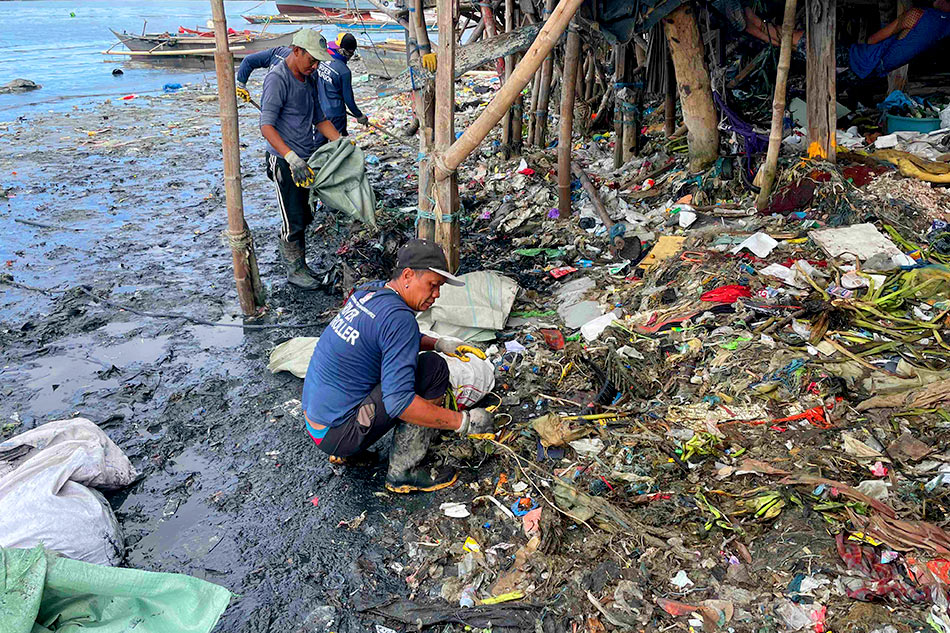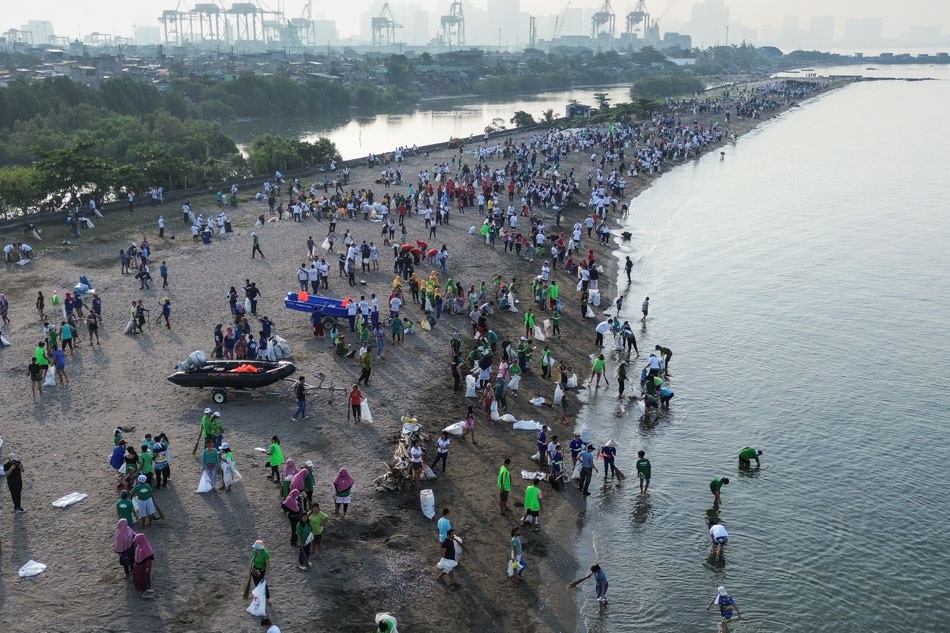Study: Millions of plastic trash found in portions of Manila Bay | ABS-CBN
ADVERTISEMENT

Welcome, Kapamilya! We use cookies to improve your browsing experience. Continuing to use this site means you agree to our use of cookies. Tell me more!
Study: Millions of plastic trash found in portions of Manila Bay
Study: Millions of plastic trash found in portions of Manila Bay
Raphael Bosano,
ABS-CBN News
Published Jan 25, 2024 11:12 PM PHT
MANILA — Researchers on Thursday revealed their findings of a massive 12 million pieces of marine litter along selected sections of the Manila Bay coastline.
MANILA — Researchers on Thursday revealed their findings of a massive 12 million pieces of marine litter along selected sections of the Manila Bay coastline.
A team of experts from De La Salle University-Dasmariñas, in partnership with the Korean International Cooperation Agency, EcoWaste Coalition, and the Department of Environment and Natural Resources (DENR), says based on their monitoring survey, 9 out of 10 of marine litter collected along the coast are different types of plastic — most of them single-use utensils, sachets, and wrappers.
A team of experts from De La Salle University-Dasmariñas, in partnership with the Korean International Cooperation Agency, EcoWaste Coalition, and the Department of Environment and Natural Resources (DENR), says based on their monitoring survey, 9 out of 10 of marine litter collected along the coast are different types of plastic — most of them single-use utensils, sachets, and wrappers.
The study, which looked at a total of 10 sites in the National Capital Region (NCR), Bataan in Central Luzon, and Cavite in CALABARZON, focused on a 100-meter survey line in each site. This stretch was further divided into 20 equal parts measuring five meters each.
The study, which looked at a total of 10 sites in the National Capital Region (NCR), Bataan in Central Luzon, and Cavite in CALABARZON, focused on a 100-meter survey line in each site. This stretch was further divided into 20 equal parts measuring five meters each.
All litter that measured more than 2.5 centimeters in each part was collected, classified, and segregated based on the type of item.
All litter that measured more than 2.5 centimeters in each part was collected, classified, and segregated based on the type of item.
ADVERTISEMENT
The survey was done in the months of February, May, August, and November 2023. The periods were picked specifically to identify differences in the amount of litter during the dry and wet season.
The survey was done in the months of February, May, August, and November 2023. The periods were picked specifically to identify differences in the amount of litter during the dry and wet season.
NCR sites saw the highest number of collected marine litter per meter. The Tanza Marine Tree Park in Navotas and Las Piñas-Parañaque Wetland Park had 256.41 and 146.33 pieces of plastic litter per meter, respectively.
NCR sites saw the highest number of collected marine litter per meter. The Tanza Marine Tree Park in Navotas and Las Piñas-Parañaque Wetland Park had 256.41 and 146.33 pieces of plastic litter per meter, respectively.
Project Director Dr. Johnny Ching explained, however, that communities near the survey sites should not be solely blamed for the enormous amount of plastic litter along the bay.
Project Director Dr. Johnny Ching explained, however, that communities near the survey sites should not be solely blamed for the enormous amount of plastic litter along the bay.
"Malaking factor 'yung current flow or direction of the current of water, as well as 'yung location ng lugar, kung mababa siya o mataas. There are several catchment basins, 'yung rivers is another malaking factor 'yan. Contributor 'yang river na naka-connect sa Manila Bay," he said.
"Malaking factor 'yung current flow or direction of the current of water, as well as 'yung location ng lugar, kung mababa siya o mataas. There are several catchment basins, 'yung rivers is another malaking factor 'yan. Contributor 'yang river na naka-connect sa Manila Bay," he said.
(The direction of the ocean’s current is one factor as well as an area’s location whether it is elevated or otherwise. Rivers are also another factor because they are connected to Manila Bay.)
(The direction of the ocean’s current is one factor as well as an area’s location whether it is elevated or otherwise. Rivers are also another factor because they are connected to Manila Bay.)
ADVERTISEMENT
While food sachets, wrappers, and single-use utensils were found in all sites surveyed, other types of litter collected also include toys, office supplies, appliances, automobile parts, clothes, beverage, and pesticide bottles, among others.
While food sachets, wrappers, and single-use utensils were found in all sites surveyed, other types of litter collected also include toys, office supplies, appliances, automobile parts, clothes, beverage, and pesticide bottles, among others.
"The number of single-use utensils becomes even enormous due to the pandemic, where single-use utensils were used to limit the spread of contagious COVID disease," the study read.
"The number of single-use utensils becomes even enormous due to the pandemic, where single-use utensils were used to limit the spread of contagious COVID disease," the study read.
Filipinos have become accustomed to buying in small quantities wrapped in individual packaging, more commonly known as the "sachet economy." It therefore no longer comes as a surprise why such kinds of plastic litter various waterways which are eventually washed out to the sea.
Filipinos have become accustomed to buying in small quantities wrapped in individual packaging, more commonly known as the "sachet economy." It therefore no longer comes as a surprise why such kinds of plastic litter various waterways which are eventually washed out to the sea.
The poor management and subsequent accumulation of these sachets have been repeatedly blamed for the severe flooding in Metro Manila following inclement weather.
The poor management and subsequent accumulation of these sachets have been repeatedly blamed for the severe flooding in Metro Manila following inclement weather.
Experts see behavioral change towards the use of single-use plastics as one of the best solutions in mitigating the growing plastic problem. But they also agree that this is easier said than done.
Experts see behavioral change towards the use of single-use plastics as one of the best solutions in mitigating the growing plastic problem. But they also agree that this is easier said than done.
ADVERTISEMENT
Nevertheless change has to emanate from somewhere. Manufacturers, according to Ching, are a good place to start.
Nevertheless change has to emanate from somewhere. Manufacturers, according to Ching, are a good place to start.
"We could recommend to manufacturers to start eliminating the use of unnecessary single-use plastics. For example plastic stirrers, these are unnecessary. We can do without them. Straws, we can do without them. We can stop producing unnecessary SUPs. And for those necessary, we can find alternatives."
"We could recommend to manufacturers to start eliminating the use of unnecessary single-use plastics. For example plastic stirrers, these are unnecessary. We can do without them. Straws, we can do without them. We can stop producing unnecessary SUPs. And for those necessary, we can find alternatives."
Experts add that even those considered biodegradable plastics are not completely helping. While they may break down faster than ordinary plastics, this process only increases the chance of micro- and nanoplastics in the atmosphere, water surfaces, and even food.
Experts add that even those considered biodegradable plastics are not completely helping. While they may break down faster than ordinary plastics, this process only increases the chance of micro- and nanoplastics in the atmosphere, water surfaces, and even food.
The study, according to the Ecowaste Coalition, aims to add onto the body of knowledge on plastic pollution in the Manila Bay and eventually measure the effectiveness of enacted laws whose primary purpose is to ensure that the country’s solid waste is properly managed.
The study, according to the Ecowaste Coalition, aims to add onto the body of knowledge on plastic pollution in the Manila Bay and eventually measure the effectiveness of enacted laws whose primary purpose is to ensure that the country’s solid waste is properly managed.
The monitoring survey will be conducted for another two years, in 2024 and 2025.
The monitoring survey will be conducted for another two years, in 2024 and 2025.
Read More:
Manila Bay
plastic pollution
single-use plastics
EcoWaste Coalition
De La Salle University-Dasmariñas
Korean International Cooperation Agency
Department of Environment and Natural Resources
DENR
climate
ADVERTISEMENT
ADVERTISEMENT




